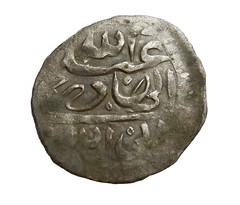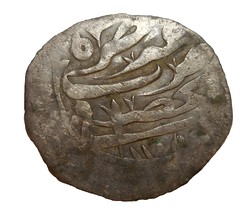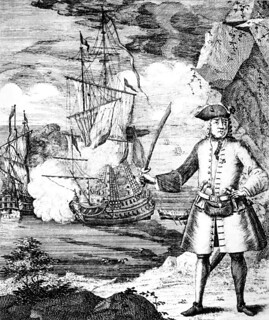
PREV ARTICLE
NEXT ARTICLE
FULL ISSUE
PREV FULL ISSUE
ARABIAN SILVER COINS IN THE AMERICAN COLONIESJim Bailey of Warwick, RI published an article in the 164th issue of Colonial Newsletter (published by the American Numismatic Society) titled Late 17th Century Arabian
Coins Found in Southern New England: Uncovering the Evidence and History of Red Sea Piracy in Early America. With permission, here is an excerpt. -Editor
  This article offers a detailed study of Arabian silver coins that briefly circulated in the American Colonies at the close of the 17th century. The substance of the article is unprecedented in several respects. It advances the study of a subject matter hardly considered until now. Oliver Hoover's "The Real Forgotten Coins of North America" is the only past contribution of note, examining in part a detectorist's discovery of an unusual coin fragment of Arabian silver from the late 17th century found in Newport, RI. Hoover's study concludes in pondering the possibility of recovering other such coins on North American soil. The possibility comes to fruition in this article reporting on the discovery of a second specimen of Arabian silver – an intact, sharply detailed coin dating from 1693. It was eventually identified as a comassee coin from Yemen. The coin was found at a colonial period site by this author while metal detecting in Rhode Island - a mere five miles away from where the first fragmented specimen was recovered. The first ever documented recovery of a complete coin provided in this study helps mitigate reasonable concerns with solitary finds, which can be dismissed as inexplicable anomalies. In addition, other hard evidence has been found. This author's ongoing interest in the recovered coin and numerous contacts with other detectorists in Southern New England led to the knowledge of other such coin recoveries presently totaling nine known specimens - four whole coins and five fragments. The recovery of several such coins from one small region calls for investigation. This article answers the call reviewing a wealth of primary source documents relating to the origin of the coins from a distant part of the world, their unconventional conveyance to the American Colonies, and their illicit, brief circulation on the Atlantic seaboard. Examination of these coins offers unique insight into a subject matter previously limited to the study of historical records alone. Hoover's contribution notes a number of possible sources for Islamic coins of gold and silver circulating in the American Colonies – piracy, the coffee trade, and the East African slave trade. Similarly, a study of Dutch leeuwendaalders (lion dollars) by John Kleeberg considers piracy and the East African slave trade in particular as sources for these coins that circulated in the colonies. This study advances a singular premise: the recovered coins detailed in this article are a small sampling of riches brought back to American Colonies by pirates who preyed upon the rich shipping lanes of the Red Sea and the Indian Ocean. This specific study of pirate plunder in the American Colonies offers an intriguing look at local economies benefitting from piracy at the expense of emerging world trade. The steady drain of gold and silver specie from the colonies to England is a well-known though narrowly viewed subject in colonial numismatics. England was not a final stop but more of a way station particularly for silver, which went further eastward to finance the cost of doing business for the British East Indies Company in its dealing with the Mughal Empire (modern day India). The Mughal Empire had other trade partners, and they as well paid out in gold and silver coins, but some of this wealth never made it to the roadsteads of the mighty Mughal Empire. It was instead taken in brazen attacks by pirates from the American Colonies. In 1696 King William the III contended with the problem of piracy by issuing a proclamation for the capture of pirates "who may be probably known and discovered by the great quantity of Persian and Indian gold and silver which they have with them." It is this author's opinion and the purpose of this article to prove that the subject coins in this study were part of the foreign silver that King William referred to in his 1696 proclamation. Pirate attacks that occurred throughout the 1690's would in short time pose a real threat to England's trade in the East Indies. Yet all was happy in the American Colonies. Pirate crews returning home from a successful voyage were welcomed with open arms as they returned with gold and silver that helped alleviate the economic strain caused by England's heavy draining of precious metals from the American Colonies. The much needed infusion of gold and silver helped fuel the local economy of select seaports, benefitting ship owners and prosperous merchants in particular, as well as shop owners, tavern keepers, tradesmen, and others as the money changed hands. Most must have known the illicit source for the foreign coins, but the money came and went in day-to-day transactions with few questions or concerns. There was little fear of consequences for those trying to scrape a living on the outer reaches of a rising British Empire. Jim provided this summary of the article's main points and conclusions. He can be contacted at jbailey1652@gmail.com . Thank you!
As an additional illustration, Jim added an image of "CAPT. AVERY and his crew taking one of the GREAT MOGUL's Ships." from Johnson, Charles, A General and True History of the Lives and Actions of the Most Famous Highwaymen, Murderers, Street-Robbers &c. To Which Is Added, a Genuine Account of the Voyages and Plunders of the Most Noted Pyrates, London, 1734. -Editor
For more information on the Colonial Newsletter, see: THE BOOK BAZARREWayne Homren, Editor The Numismatic Bibliomania Society is a non-profit organization promoting numismatic literature. See our web site at coinbooks.org. To submit items for publication in The E-Sylum, write to the Editor at this address: whomren@gmail.com To subscribe go to: https://my.binhost.com/lists/listinfo/esylum All Rights Reserved. NBS Home Page Contact the NBS webmaster 
|
